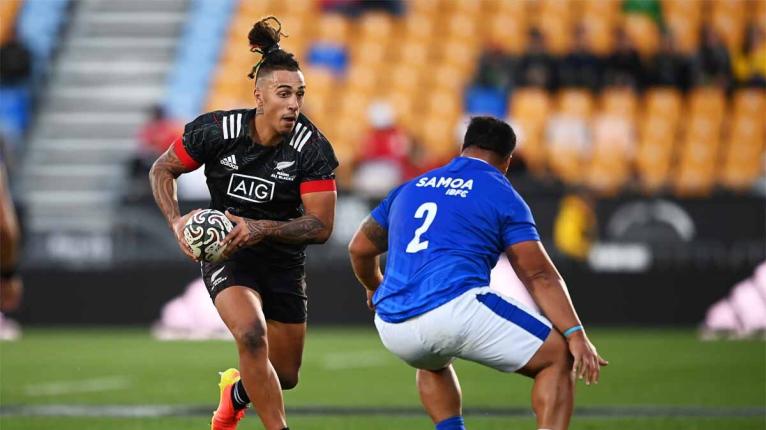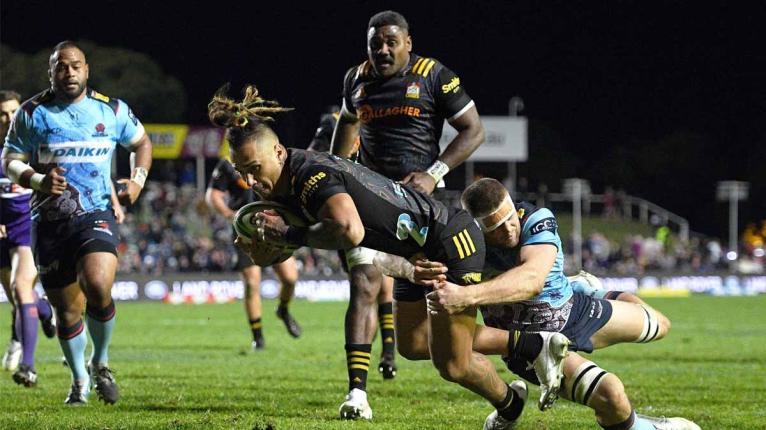The moments before kick-off in last years historic Maori All Blacks Moana Pasifika match in Hamilton were as spine-tingling as it gets.
As the visiting team, Moana Pasifika are the first to challenge, bringing together the Samoan Sivi Tau, the Tongan Sipi Tau, and the Fijian Cibi.
Then the Maori respond with Timatanga, the haka that tells of the creation, the coming together of young warriors, urging them to reach for the skies and climb the highest peaks.

As it rises to a crescendo, Ash Dixon, bearing the ceremonial patu, weaves through his teammates to the front of the group, the leader of the team.
But the initial call of the players to come together and the commanding voice through the first powerful phase is of a young man of Ngai Tuhoe and Ngati Porou.
Sean Wainui has this honour because he is a leader, not in terms of whether to kick for goal or touch, but in terms of the connection to their tupuna, those that have gone before them, and their commitment to tikanga, the centuries-old protocols that they follow.
Sean Wainui’s mountain peak was the Maori All Blacks. It’s the team he most wanted to play for from a young age. He would not have been out of place in the All Blacks but now we will never know.
He became a popular member of that team with his indefatigable appetite for training, and his impish sense of humour, striking up a close bond with a number of players
His death in a car accident, at the age of 25, has sent the New Zealand rugby scene into a state of shock and grief for a young man stopped in his prime and leaving behind a wife and two gorgeous young kids.
It was Colin Cooper who first recognised Wainui’s talent, signing him out of college on Auckland’s North Shore for Taranaki. From there he made the champion New Zealand side for the 2015 Under 20 World Cup in Italy, and earned an invitation to the coveted ranks of the Crusaders.
He became a popular member of that team with his indefatigable appetite for training, and his impish sense of humour, striking up a close bond with a number of players including Codie Taylor, who broke down this week in trying to express the grief he and his teammates were feeling, and Sam Whitelock, whom tradition/superstition/routine dictated he always sat next to on the plane.
He later moved to the Chiefs, scoring a record five tries in their Super Rugby rout of the Waratahs earlier this year, charming the Aussie studio presenters with his humility and his disarming natural manner.

He played what tragically turned out to be his last matches for Bay of Plenty in the NPC.
But it was his appearance for the Maori All Blacks that meant the most to him. A concept that came dangerously close to being phased out in the late 60s that has once again become a vital part of the tapestry of New Zealand rugby.
There are those who question why New Zealand would have a “racially” selected side like this, but that is far too simplistic an approach. To have such a team is a recognition of Maori as the tangata whenua, people of the land, a tribute to the incredible contribution Maori players have made to New Zealand rugby, and in some ways a celebration of the survival and renaissance of a culture and a language. Wainui, bearing many of the attributes of the great Maori players along with his passion for the culture and his fluent capabilities with te reo Maori, was the perfect fit.
There is a very sad sense that while he was incredibly popular amongst the playing fraternity, the rest of us were just really starting to get to know him.
His post-match interviews would always begin with a mihi, a traditional introductory tribute to those who have passed before him, and to those now around him, and no matter how well he had played, or how many tries he had scored, he would take none of the credit, preferring to praise the work of those who had given him the ball.
As a player, he just kept improving. His dedication to his fitness, and determination to keep getting better, made him a coaches dream. A tall man at 1.92 (6’3”) he was not especially fast for a wing three-quarter, but he played fast. He knew how to carry strongly, run the best lines on attack, and he was an excellent finisher, and a truly outstanding defender. Above all, he was accurate in everything he did, and hardly ever got it wrong.
There is a very sad sense that while he was incredibly popular amongst the playing fraternity, the rest of us were just really starting to get to know him.
As it says in the Chiefs’ tribute to their fallen brother: Moe mai ra e te rangatira.
Sleep well, Chief.



Beautiful tribute
This comment rung very true: "There is a very sad sense that... the rest of us were just really starting to get to know him." Absolutely heartbroken for his family.
Awesomely put TJ . Haere ra Sean!....Condolences to all his whanau....... and to all our AB's who knew Sean better than the rest of us please play your last five tests overseas with the same elan that he always showed on the field as a fitting tribute 🙃 😎 we all know you will guys!!! 😍
Fabulous tribute.